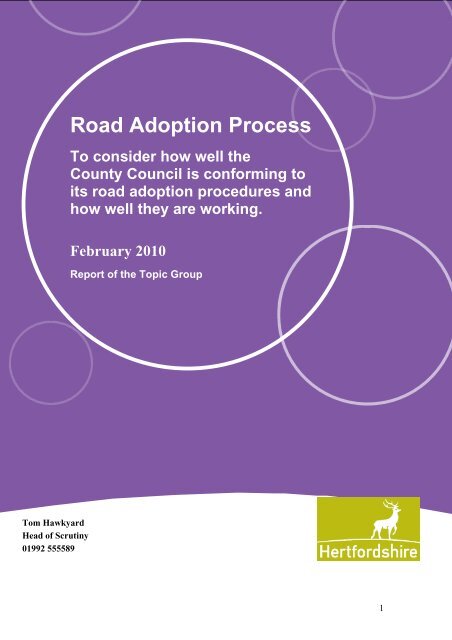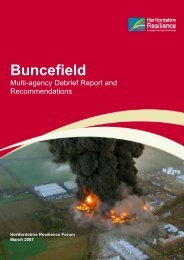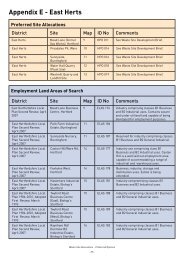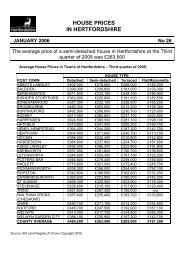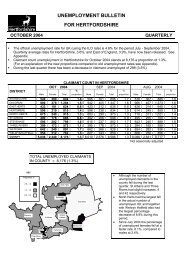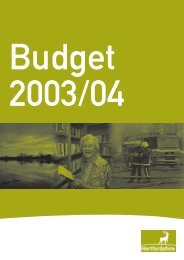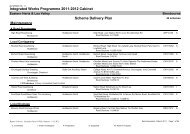26-Mar-10 - Hertfordshire County Council
26-Mar-10 - Hertfordshire County Council
26-Mar-10 - Hertfordshire County Council
You also want an ePaper? Increase the reach of your titles
YUMPU automatically turns print PDFs into web optimized ePapers that Google loves.
Road Adoption Process<br />
To consider how well the<br />
<strong>County</strong> <strong>Council</strong> is conforming to<br />
its road adoption procedures and<br />
how well they are working.<br />
February 20<strong>10</strong><br />
Report of the Topic Group<br />
Tom Hawkyard<br />
Head of Scrutiny<br />
01992 555589<br />
1
Contents<br />
1.0 Purpose of Report 3<br />
2.0 Recommendations 3<br />
3.0 Background 4<br />
4.0 Conclusions 5<br />
5.0 Members and Witnesses 9<br />
Appendix 1 Scoping Document<br />
2
ROAD ADOPTION PROCESS TOPIC GROUP REPORT<br />
1.0 Purpose of Report<br />
1.1 This is the report of the Road Adoption Process Topic Group which<br />
eamines how well the <strong>County</strong> council is conforming to its road adoption<br />
procedures and assesses how well they are working.<br />
1.2 The scoping document can be seen at Appendix 1. The papers issued<br />
to Members prior to the meeting can be found at: RAPTGAgendapapers<br />
1.3 It should be noted that the report does not seek to address specific road<br />
adoption schemes, though some case studies were presented as evidence<br />
in order to illustrate a number of the problems members heard about.<br />
2.0 Recommendations<br />
2.1 To ask the Chairman of OSC to write to all <strong>Hertfordshire</strong> MP’s and the Local<br />
Government Association (LGA) expressing concerns at the inability of local<br />
authorities to oblige developers to enter S38 Agreement in order that<br />
highways can be adopted and asking that a way of altering legislation be<br />
explored. (4.1)<br />
2.2 To ensure, where possible, there is:<br />
• one named contact in the Environment Department for districts and<br />
developers to contact when dealing with large developments,<br />
• a close working relationship between district and county officers<br />
throughout the planning process that takes advantage of local<br />
knowledge,<br />
• continuity of officers dealing with large applications,<br />
• improved communication between staff within Environment and between<br />
Environment and Mouchel,<br />
• early intervention in the adoption process,<br />
• clarity on the fees to be charged from the outset of agreements,<br />
• only one request to deal with remedial works,<br />
• a speedy highway and/or street lighting inspection at the end of the<br />
adoption process. (4.6, 4.7 and 4.8)<br />
2.3 To ask the Environment Department to make the utility companies aware of<br />
the difficulties their organisations can cause in the process of adoption. (4.7)<br />
2.4 To investigate whether the <strong>County</strong> <strong>Council</strong> should suggest that that<br />
developers use S37 of the Highways Act to offer roads for adoption. (4.<strong>10</strong>)<br />
2.5 To ask the Overview and Scrutiny Committee (OSC) to undertake a scrutiny<br />
in 18 months time that focuses on measuring the effectiveness of the<br />
implementation of the recommendations on highways adoption agreed by<br />
the Highways and Transport Panel at their meeting on <strong>10</strong> th November 2009.<br />
(4.11)<br />
3
3.0 Background<br />
3.1 The scrutiny has arisen following concern from members of the <strong>County</strong><br />
<strong>Council</strong> and District <strong>Council</strong>s at the perceived time it can take for a road to<br />
be adopted and the failure of some developers to ensure that new roads are<br />
of a standard to be able to be adopted.<br />
3.2 The <strong>County</strong> <strong>Council</strong> is the Highway Authority and has a responsibility to<br />
keep all adopted public roads and pavements safe for everyone to use,<br />
however not all roads are adopted.<br />
3.3 For the Highway Authority to adopt a road it must be designed and built<br />
to adoptable standards, be on land in the ownership of the developer and<br />
connected to the public highway network. All street furniture such as street<br />
lights, etc should be approved. The foul water and surface sewers must<br />
have been adopted by the Water Authority. Section 38 of the Highways Act<br />
1980 sets out the power of Highway Authorities to adopt by agreement.<br />
3.4 The current approach to highway adoption is that all roads serving five<br />
houses or more (with the exception of short cul-de-sac), footways and<br />
verges, footpaths and cycle tracks which are necessary for public access or<br />
passage and are connected to another part of the highway maintained at<br />
the public expense will be considered for adoption. Commercial and<br />
industrial roads are considered for adoption where there is a clear benefit to<br />
the general public or in the interest of creating an improved highway<br />
network or better management of traffic<br />
3.5 Private roads and streets are not maintained by the <strong>County</strong> <strong>Council</strong> and<br />
could be in a condition that does not meet the standard of adopted roads.<br />
They are also not covered by the Environmental Protection Act. The<br />
responsibility for private roads and streets lies with the road owners. The<br />
<strong>County</strong> <strong>Council</strong> as Highways Authority can only maintain adopted highways<br />
where it has taken on the legal responsibility for maintenance.<br />
3.6 The adoption process is managed for the <strong>County</strong> <strong>Council</strong> by the<br />
<strong>Hertfordshire</strong> Highways Service Management Team (HCC), with technical<br />
support from the <strong>Hertfordshire</strong> Highways Design Team (Mouchel).<br />
The exceptions to this situation are in Broxbourne and Stevenage where the<br />
boroughs still have Agency Agreements with the <strong>County</strong> <strong>Council</strong>, under<br />
which they are responsible for the adoption process in relation to residential<br />
roads.<br />
3.7 The scrutiny focussed on four areas:<br />
• How does the current process work?<br />
• What factors can delay the adoption process?<br />
• Do we ensure that all roads are maintained?<br />
• Can the adoption process be improved?<br />
The minutes of the scrutiny can be seen at: RAPTGAgendapapers<br />
4
4 Conclusions<br />
4.1 Members heard that when Local Planning Authorities (LPAs) grant<br />
planning permission for a development that includes new roads, they<br />
cannot impose planning conditions regarding the extent of highway<br />
adoption or the timing of the adoption process nor do they have any<br />
power to force a developer to put a road up for adoption. They were<br />
also concerned to hear that there are no incentives for developers to<br />
enter into Section 38 Agreements. As a result developers currently<br />
initiate the process by dictating when they enter into a Section 38<br />
adoption agreement. This agreement sets out the design and adoption<br />
time limits. New agreements include a bond for the entire cost of<br />
constructing the road which may be used by the Highway Authority to<br />
bring the road up to an adoptable standard should the developer<br />
default. Members also noted that in the current economic climate<br />
there is a risk that fewer Section 38 adoption agreements may be<br />
entered into because developers do not have resources to fund the<br />
bond. Members were also made aware that the Highway Authority<br />
may choose not to adopt a road where there are no highway benefits.<br />
(Recommendation 2.1)<br />
4.2 The Advance Payments Code (APC) within the Highways Act 1980<br />
secures payment of the expenses of completing the roadworks in unadopted<br />
roads next to new buildings. This makes sure that the street<br />
works authority can complete the road works if the developer fails to<br />
complete them. If work is started on a building before the appropriate<br />
sum has been paid or secured, the owner may have to pay a fine of up<br />
to £<strong>10</strong>00 per building. The Code was introduced to guard against the<br />
post-war problem of small speculative developers and offers no<br />
protection for the Highway Authority on today’s large developments<br />
where access roads may not have houses on the road and therefore<br />
not be covered by the Code or where there are many properties each<br />
of which has to be dealt with separately and strict time constraints<br />
which preclude this action.<br />
4.3 Members were advised that the APC is not implemented by <strong>Hertfordshire</strong><br />
<strong>County</strong> <strong>Council</strong> and has not been for at least 30 years. Some of the districts<br />
followed it when they had highway agency agreements as the necessary<br />
communication between planners, building control and highways was much<br />
easier in one organisation. Officers have recently sought legal advice on the<br />
position regarding the Code. The <strong>County</strong>’s Legal Services teams share<br />
highways officers’ view that this would be highly resource-intensive and give<br />
little protection against the problems currently besetting <strong>Hertfordshire</strong>. Benchmarking<br />
against other Highway Authorities show that those following the<br />
Code are in the minority and are mostly single-tier authorities where the<br />
necessary communication between planners and highway engineers is more<br />
easily achieved. Members also noted that building control is not always<br />
managed by local authorities, possibly resulting in HCC not being notified of<br />
outcomes.<br />
5
4.4 Members were advised that there are a range of reasons why a road<br />
does not progress to adoption namely:<br />
• The whole adoption process can be delayed by the timing of the<br />
developer entering into a Section 38 agreement. Delays may occur due<br />
to developers putting road works for adoption late in the process or<br />
developers failing to enter into a legal agreement to cover design checks<br />
and supervision fees.<br />
• The developer never enters a Section 38 agreement.<br />
• In order for a road to be adopted every element of it has to be<br />
constructed to the standards set in the <strong>Hertfordshire</strong> Design Guide,<br />
‘Roads in <strong>Hertfordshire</strong> – A Guide for New Developments’ (RiH) unless a<br />
departure from standard has been agreed by HCC.<br />
• Street furniture, such as streetlights must be approved and foul water<br />
and surface water sewers must be adopted by the Water Authority.<br />
• On larger developments the completed road may be used as site access<br />
for other phases of the development and therefore adoption may be<br />
undertaken on completion of the whole development. This may raise<br />
further complications if the site is divided by different developers and on<br />
completion of construction of works some developers leave the site<br />
without the roads being adopted.<br />
4.5 Members were concerned to hear that when searches are undertaken<br />
on behalf of those moving house the information coming back may not be<br />
explicit as to whether a road is going to be adopted i.e. it may indicate a<br />
Section 38 agreement is being progressed even when there is no likelihood<br />
of a road actually being adopted.<br />
4.6 Members heard from HTCOA (<strong>Hertfordshire</strong> Technical Chief Officers<br />
Association) of the importance of continuity of contacts particularly when<br />
managing the process around large developments where it is easiest to<br />
have one person at HCC acting as the main contact. HTCOA emphasised<br />
the importance of good communications between the county and district<br />
over planning issues noting that where there are a number of people who<br />
have to be contacted in order to reach a decision that the process<br />
immediately slows up and decision making may not be as effective.<br />
(Recommendation 2.2)<br />
4.7 Members took verbal and written evidence from District <strong>Council</strong>lors and<br />
officers. Key points made were:<br />
• Residents on unadopted roads continue paying the full <strong>Council</strong> Tax but<br />
could be precluded from receiving a full range of environmental services<br />
and are not covered by the Environmental Protection Act.<br />
• Delays in the adoption of sewers has the knock on effect of delaying the<br />
adoption of a road. (Recommendation 2.3)<br />
• The <strong>County</strong> policy of seeking to adopt roads with more than five<br />
houses on them may be unsustainable in the longer term given the<br />
pressure on highways maintenance budgets.<br />
6
• Developers should be encouraged to set up management<br />
companies to take responsibility for unadopted roads and the<br />
associated services.<br />
• The importance of regular checks on sites.<br />
• Close working between the planning and highway authorities.<br />
(Recommendation 2.2)<br />
4.8 Members took evidence from TDS (Technical and Design Services<br />
who work on behalf of house builders to assist with adoption of roads.<br />
They specialise in sewerage and highway developments. Their<br />
representatives fed back to the Topic Group their experiences and<br />
those of developers in <strong>Hertfordshire</strong> when dealing with the adoption<br />
process. Their main concerns were:<br />
• Poor communications.<br />
• Lack of cohesion within parts of Environment and between HCC<br />
and Mouchel.<br />
• The length of time it takes to get the various approvals.<br />
• A lack of understanding of the fee structure allied to a perception<br />
there is overcharging with fees sometimes as high as the remedial<br />
work undertaken.<br />
• Multiple inspections.<br />
• Safety Audits at odds with the technically approved drawings.<br />
• Slowness of street lighting inspections.<br />
(Recommendation 2.2)<br />
4.9 TDS emphasised that generally developers were keen to enter S38<br />
agreements not least because they did not want the liabilities associated<br />
with an unadopted infrastructure. They also acknowledged that the service<br />
they and developers get from HCC is improving.<br />
4.<strong>10</strong> Members took evidence from the Highways Development Control Manager<br />
at Cambridgeshire <strong>County</strong> <strong>Council</strong> where many of the concerns raised in<br />
<strong>Hertfordshire</strong> are also being experienced. Cambridgeshire did not apply the<br />
APC and agreed with the limitations of the approach expressed in other<br />
evidence. Members were particularly interested to hear how in certain very<br />
particular circumstances the <strong>County</strong> were using S37 of the Highways Act<br />
1980 to adopt roads. S37 allows a developer who has built a road to offer it<br />
for adoption. The local authority can only refuse to adopt it if it offers no<br />
public utility or has not been constructed properly. Members asked that<br />
Environment look at whether this is an approach <strong>Hertfordshire</strong> could use to<br />
clear some of the backlog. (Recommendation 2.4)<br />
7
4.11 Members were advised that a report on Highway Adoption for New Roads<br />
had been to the <strong>10</strong> th November Highways & Transport Panel. The key<br />
recommendations of the report, which are now being introduced, are:<br />
a) In order to give greater clarity:<br />
on developments with no through route, only the main access road will<br />
be considered for adoption. Residential access roads serving<br />
underground car parks, supported by structures or taking the form of<br />
short cul-de-sac with no wider highway benefit will not be considered for<br />
adoption.<br />
b) In order to give earlier certainty:<br />
the extent of adoption should be agreed in principle by the developer<br />
and Highway Authority (planning and implementation teams) at the<br />
planning stage. This should be recorded in the planning consultation<br />
response.<br />
c) In order to achieve a signed Section 38 Agreement as quickly as<br />
possible:<br />
pressure should be brought to bear on developers to enter into S 38<br />
Agreements by the use of highway informative notes in the planning<br />
consultation response.<br />
d) In order to ensure long-term maintenance of un-adopted roads for the<br />
benefit of residents:<br />
if the developer states that they do not want to offer roads for adoption,<br />
the long term maintenance of private (un-adopted) roads in residential<br />
developments should be secured as a standard requirement through a<br />
S<strong>10</strong>6 obligation.<br />
e) In order to give greater clarity to residents:<br />
street name plates on un-adopted roads should clearly identify them as<br />
such (this will require co-operations with the developer / LPA)<br />
f) In order to improve joint working for collective benefit:<br />
it is recommended that the aspects requiring cooperation of the Local<br />
Planning Authorities are discussed with them and protocols established<br />
under the Pathfinder banner.<br />
g) In order to reduce the numbers of roads waiting to be adopted:<br />
the backlogs of historical adoptions should continue to be actively<br />
managed down by <strong>Hertfordshire</strong> <strong>County</strong> <strong>Council</strong> officers as quickly as<br />
resources permit.<br />
Members of the Topic Group endorsed these changes, though some<br />
members were concerned that the decision not to adopt cul-de-sacs may<br />
prove problematic. They asked that OSC consider adding to their work<br />
programme a further one day scrutiny of Road Adoptions, to take place<br />
in the autumn of 2011, that focussed on the implementation of the<br />
recommendations detailed above. (Recommendation 2.5)<br />
8
5 Members and Witnesses<br />
Members<br />
Eddie Roach (Chairman)<br />
Geoff Churchard (Vice - Chairman)<br />
Rose Cheswright<br />
Fiona Hill<br />
Chris Mitchell<br />
Other Members in attendance<br />
Terry Heritage Deputy Executive Member for Highways and Transport<br />
(day 2)<br />
Stuart Pile Executive Member for Highways and Transport (day 1)<br />
Alan Searing Chairman Overview and Scrutiny Committee (OSC)<br />
Witnesses<br />
Chris Conway Planning Director (Strategy and Development)<br />
Welwyn/Hatfield Borough <strong>Council</strong><br />
Paul Fleming Associate Development Director Technical and Development<br />
Services (Midlands) on behalf of house builders<br />
Nick Gough Western Area Highways Development Control Manager HCC<br />
Tom Greasley Development Engineer Technical and Development<br />
Services (Midlands) on behalf of house builders<br />
David Humby Head of Transportation Planning and Policy HCC<br />
Steve Johnson Head of Network Management <strong>Hertfordshire</strong> Highways<br />
Paul Mason <strong>Council</strong>lor and Chair of Environmental Services Committee<br />
Broxbourne Borough <strong>Council</strong><br />
Walter Osedeme Senior Engineer (Transport and Development) Stevenage<br />
Borough <strong>Council</strong><br />
Brian Peers City and District Engineer St Albans City and District<br />
<strong>Council</strong><br />
Sue Reynolds Highways DC Manager Cambridgeshire CC<br />
Tony Swendell <strong>Council</strong>lor St Albans City and District <strong>Council</strong><br />
Vetti Vettivelu. Highways Development Control Manager HCC<br />
Officers<br />
Tom Hawkyard<br />
Adrian Service<br />
Head of Scrutiny<br />
Democratic Services Officer<br />
9
SCRUTINY REMIT: <strong>Hertfordshire</strong> <strong>County</strong> <strong>Council</strong>’s Appendix 1<br />
Road Adoption Process<br />
TITLE: of Topic Group :<br />
Road Adoption Process Topic Group<br />
OBJECTIVE:<br />
To assess how well the <strong>County</strong> <strong>Council</strong> is conforming to its road adoption<br />
procedures and how well they are working.<br />
QUESTIONS TO BE ADDRESSED :<br />
1. How does the current process work?<br />
2. What factors can delay the adoption process?<br />
3. Do we ensure that all roads are maintained?<br />
4. Can the adoption process be improved?<br />
OUTCOME :<br />
To establish whether anything could be done to improve the road adoption process.<br />
CONSTRAINTS :<br />
Case studies may be presented as evidence, but individual schemes will not be<br />
discussed.<br />
EVIDENCE & WITNESSES:<br />
Road adoption Policy and Process Witness<br />
Policy and process on adoption<br />
David Humby – Head of Transportation<br />
(including report to Highway and Planning and Policy.<br />
Transport Panel meeting <strong>10</strong>/11/09)<br />
Highway design standards- Response to Nick Gough – Area Highways<br />
planning application consultation. Development Control Manager for<br />
Roads in Herts and Manual for Streets. SW <strong>Hertfordshire</strong><br />
Benchmarking<br />
Role and responsibility of the planning District <strong>Council</strong> Witness.<br />
authority on internal design and extent of Chris Conway– WHDC<br />
adoption<br />
Brian Peers- St Albans City& DC<br />
Implementation Process - S38<br />
Steve Johnson – Head of Network<br />
Design/supervision/ legal agreements, Management<br />
contacts with utility bodies, bonds and<br />
completion certificate<br />
Alternative approach – Advance Payment Vetti Vettivelu. - Highways Development<br />
Code – benefits and dis benefits and why Control services Manager.<br />
it is not a suitable route for HCC<br />
Way forward on road adoption to ensure David Humby - Head of Transportation<br />
adequate processes are in place for Planning and Policy.<br />
speedy adoption or long term maintenance<br />
Concerns Over Adoption District <strong>Council</strong> Members –<br />
Cllrs Paul Mason and Tony Swendell<br />
<strong>10</strong>
Road adoption issues from the house<br />
builders point of view<br />
Policy and process on adoption<br />
(including report to Highway and<br />
Transport Panel meeting <strong>10</strong>/11/09)<br />
Highway design standards- Response to<br />
planning application consultation.<br />
Roads in Herts and Manual for Streets.<br />
Benchmarking<br />
Tom Greasley & Paul Fleming – Home<br />
Builders Federation<br />
David Humby – Head of Transportation<br />
Planning and Policy.<br />
Nick Gough – Area Highways<br />
Development Control Manager for<br />
SW <strong>Hertfordshire</strong><br />
METHOD: One off scrutiny over 2 days DATES: 24 & 25 February 20<strong>10</strong><br />
MEMBERSHIP :<br />
Rose Cheswright, Geoff Churchard, Fiona Hill, Chris Mitchell & Eddie Roach<br />
SUPPORT :<br />
Scrutiny Officer: : Tom Hawkyard<br />
Lead Officers: David Humby<br />
Democratic Services Officer: Adrian Service<br />
HCC Priorities for Action : - how this item helps deliver the Priorities<br />
The following statement demonstrate how appropriate adoption of roads aids<br />
in the delivery of the below list HCC Priorities.<br />
When highways are not adopted it can lead to issues in relation to maintenance<br />
of road, street cleaning, lack of pedestrian facilities, poor standards of street<br />
lighting, drainage, highway enforcement on parking/obstruction , poor<br />
appearance of residential area and local amenity.<br />
Properly designed and built roads to adoptable standard and maintained either<br />
by the local highway authority or other private arrangements would improve<br />
and enhance the delivery of priorities listed below:<br />
1. Support economic well being<br />
2. Maximise independent living<br />
3. Reduce carbon emissions<br />
4. Promote safe neighbourhoods<br />
5. Be a leading council<br />
CfP’S OBJECTIVES :<br />
1. Provides a critical friend challenge to executive policy makers and decision makers<br />
2. Enables the voice and concerns of the public to be heard<br />
3. Is carried out by independent governors who lead and own the scrutiny role<br />
4. Drives improvement in public services<br />
11
For further information about this report please contact:<br />
Tom Hawkyard<br />
Head of Scrutiny<br />
Room 322,<br />
<strong>County</strong> Hall,<br />
Hertford,<br />
SG13 8DQ<br />
Tel: 01992 555589<br />
www.hertsdirect.org<br />
12


